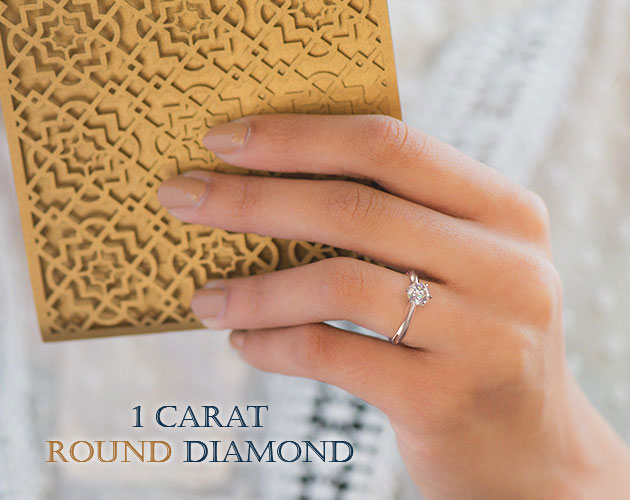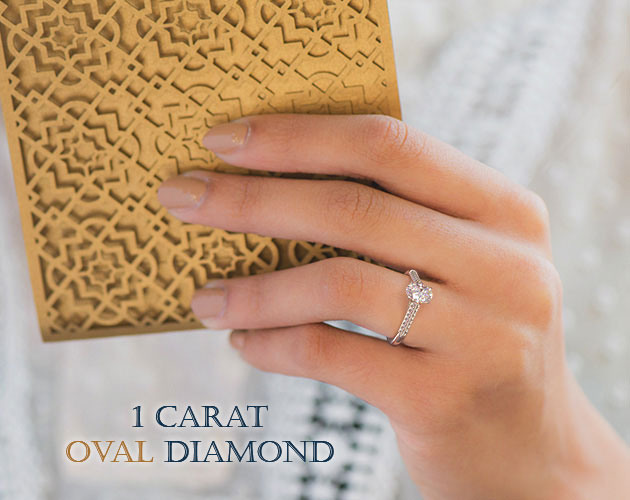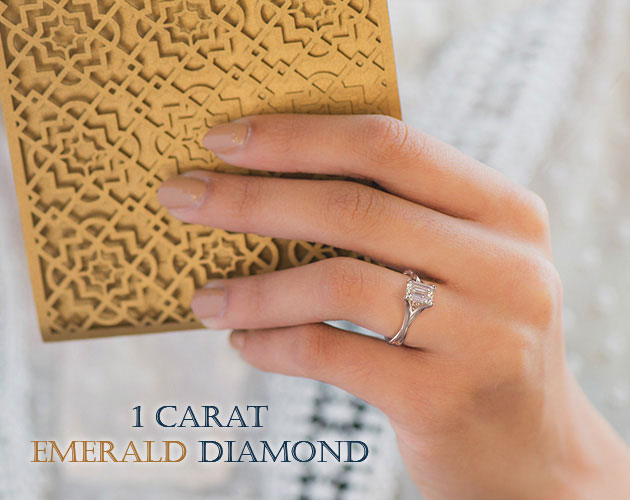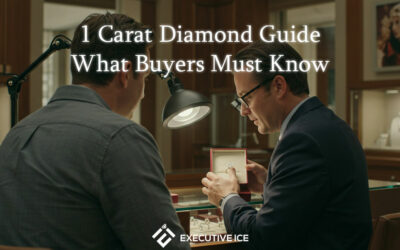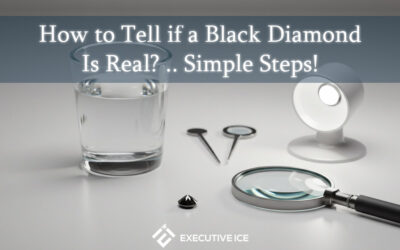Hey there, diamond enthusiasts! Ever wonder what we’re talking about when we mention ‘carat’ in the world of diamonds? Well, it’s not about carrots that rabbits love to munch on. In diamond talk, carat has a whole different meaning.
In the simplest terms, carat is all about the weight of the diamond. Think of it like weighing a feather on a scale. A carat is a unit that measures how much a diamond weighs. One carat is equal to 200 milligrams, or about the weight of a paperclip. It’s a way for us to understand how big or small a diamond is.
But here’s a little twist – carat weight doesn’t always directly tell you about the size of the diamond as it looks to the eye. It’s like two birds that weigh the same but look different in size due to their feathers and shape.
The idea of using carats to weigh diamonds goes way back. It started with the carob seed, which was used in ancient times as a reference for weighing precious stones because these seeds had a pretty uniform weight.
So, when we talk about carats in diamonds, we’re talking about how much the diamond weighs, which gives us a hint about its size. It’s a key piece of the puzzle when picking out that perfect diamond, along with its cut, color, and clarity.
And that’s the scoop on carats. As we delve deeper into this guide, you’ll see just how important this tiny unit of weight is in the dazzling world of diamonds. Stay tuned!
1. Introduction
-
Overview of the importance of carat in diamond valuation
Let’s dive into why the carat of a diamond is such a big deal when we talk about its value. Carat weight is like a key that unlocks a big part of a diamond’s story, especially its value.
In the diamond world, carat weight is a big player in how much a diamond is worth. It’s a bit like the way we value gold. The more you have, the more valuable it is. But with diamonds, it’s not just about how much they weigh. It’s about finding that sweet balance between size, beauty, and rarity.
The higher the carat weight, the rarer the diamond usually is. It’s like finding a larger, perfectly shaped leaf in a forest; they’re not as common, so they’re more precious. This rarity bumps up the value of the diamond. A diamond that’s big and also has good color and clarity can be something really special, like a rare gem in a treasure chest.
But here’s something to keep in mind – bigger isn’t always automatically better. A larger diamond with poor color and clarity might not be as valuable as a smaller diamond with excellent color and clarity. It’s all about the balance of all these factors.
So, when you’re thinking about a diamond carat, remember it’s a big part of the diamond’s value. It tells you about the rarity and size of the gem, but it’s just one part of the whole picture. In the next sections, we’ll explore how carat relates to other aspects like size and price, helping you understand how to find the best diamond for you.
2. Understanding Diamond Carat
-
Historical Background and Origin of the Carat System
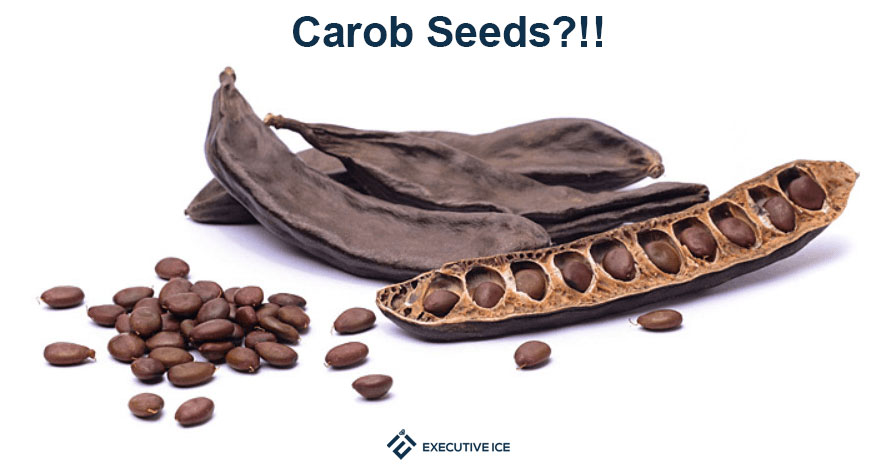
Well, gather ’round, ’cause we’re about to step back in time to understand where this whole idea of measuring diamonds by carats came from. The story of the carat system is like a trail through history, winding through different cultures and times.
The word ‘carat’ itself comes from the ‘carob’ seed. Way back in ancient times, folks used these small seeds to balance scales when weighing precious stones. Why carob seeds? Well, because they’re pretty consistent in size and weight, making them a handy natural standard for weighing gems. It’s like using a teaspoon from your kitchen to measure ingredients – it’s something small and handy.
This practice of using carob seeds spread through the trading routes, from the ancient markets in the Middle East to the bazaars in the Mediterranean. Traders and merchants across the ages relied on these seeds for a fair deal.
But as time went on and trading grew more precise, there was a need for a more accurate and universal standard. Enter the modern carat, officially adopted at the start of the 20th century. This system standardized the carat as exactly 200 milligrams, making it the same no matter where you are in the world. It’s like agreeing on using the same map for a journey, no matter where you start from.
So, when we talk about carats today, we’re really carrying on an ancient tradition, refined by centuries of trade and craftsmanship. It’s a fascinating blend of nature and history, all coming together in the dazzling world of diamonds.
And that’s the tale of the carat system – a journey through time, uniting traders, jewelers, and diamond lovers across the world under one standard. It’s amazing how something as small as a seed could lead to a system that now measures the beauty and worth of diamonds worldwide.
-
Detailed explanation of the carat measurement
So, we know a carat is a unit of weight, but how does that translate to these precious stones?
A carat, equal to 200 milligrams, is the standard measure for a diamond’s weight. It’s like weighing a tiny bird on a scale – the scale needs to be pretty sensitive to get it right. In the diamond world, even a fraction of a carat can make a big difference in value. It’s kind of like how a few extra grains can tip the scale.
Now, each carat can be divided into 100 points. This allows for a very precise measurement. Think of it as dividing an inch into 100 parts. A diamond that weighs 0.50 carats is the same as a 50-point diamond. This precision helps when it comes to determining a diamond’s price and comparing weights.
The carat system we use today started with the carob seed, which was used centuries ago as a small, consistent unit for weighing precious stones. Over time, this evolved into the modern carat system.
But here’s something to ponder: two diamonds of the same weight can still look different in size. That’s because how big a diamond looks depends not just on its weight, but also on its cut and shape. A well-cut diamond can appear larger than another diamond of the same weight but with a poorer cut.
So, when you hear about a diamond’s carat weight, think of it as an important part of the story, but not the whole story. It’s a key chapter in understanding a diamond’s value and beauty, but there’s more to consider, like the sparkle, the cut, and the clarity. Stick around as we explore all these aspects and how they dance together in the world of diamonds.
3. Carat Weight vs. Size
-
Explaining the difference between carat weight and apparent size
Let’s clear up a common confusion in the diamond world – the difference between carat weight and how big a diamond actually looks, or its apparent size.
Now, when we talk about carat weight, remember, we’re talking about how much a diamond weighs. It’s a measure of its heft, not how big it looks. It’s kind of like comparing two animals that weigh the same but are different in size – like a fluffy rabbit and a sleek otter.
The apparent size, on the other hand, is how large or small the diamond appears when you look at it. This can be tricky because two diamonds with the same carat weight might not look the same size. How’s that? Well, it’s all about the diamond’s cut.
A diamond’s cut can affect its spread – that’s how much surface area it shows on the top. A diamond that’s cut deeper might have more weight hidden below, making it look smaller from above. On the flip side, a shallower cut diamond might spread its weight more, appearing larger to the eye. It’s like two bowls that hold the same amount of water, but one is wide and shallow while the other is narrow and deep.
So, when you’re looking at diamonds, remember that carat weight isn’t the only thing that decides how big the diamond will look on your finger. The cut plays a big part in this illusion of size.
That’s why it’s important to look at both the carat weight and the cut to get a true sense of how large a diamond will appear. It’s a bit like looking at both the footprint and the height of an animal to understand its true size.
Keep this in mind as we move through our guide, and you’ll be able to pick a diamond that not only has the right weight but also the perfect size and sparkle for you.
-
Diamond Measurements & Size Chart per Carat
Pictured below, here’s a closer look at diamond measurements and a handy size chart per carat. This visual guide will help you understand the typical dimensions and appearance of diamonds based on their carat weight. It’s a useful tool for visualizing how different carat weights translate into actual size, giving you a clearer idea of what to expect when selecting your diamond. Whether you’re considering a petite gem or a more substantial stone, this chart will be a valuable reference in your diamond journey.
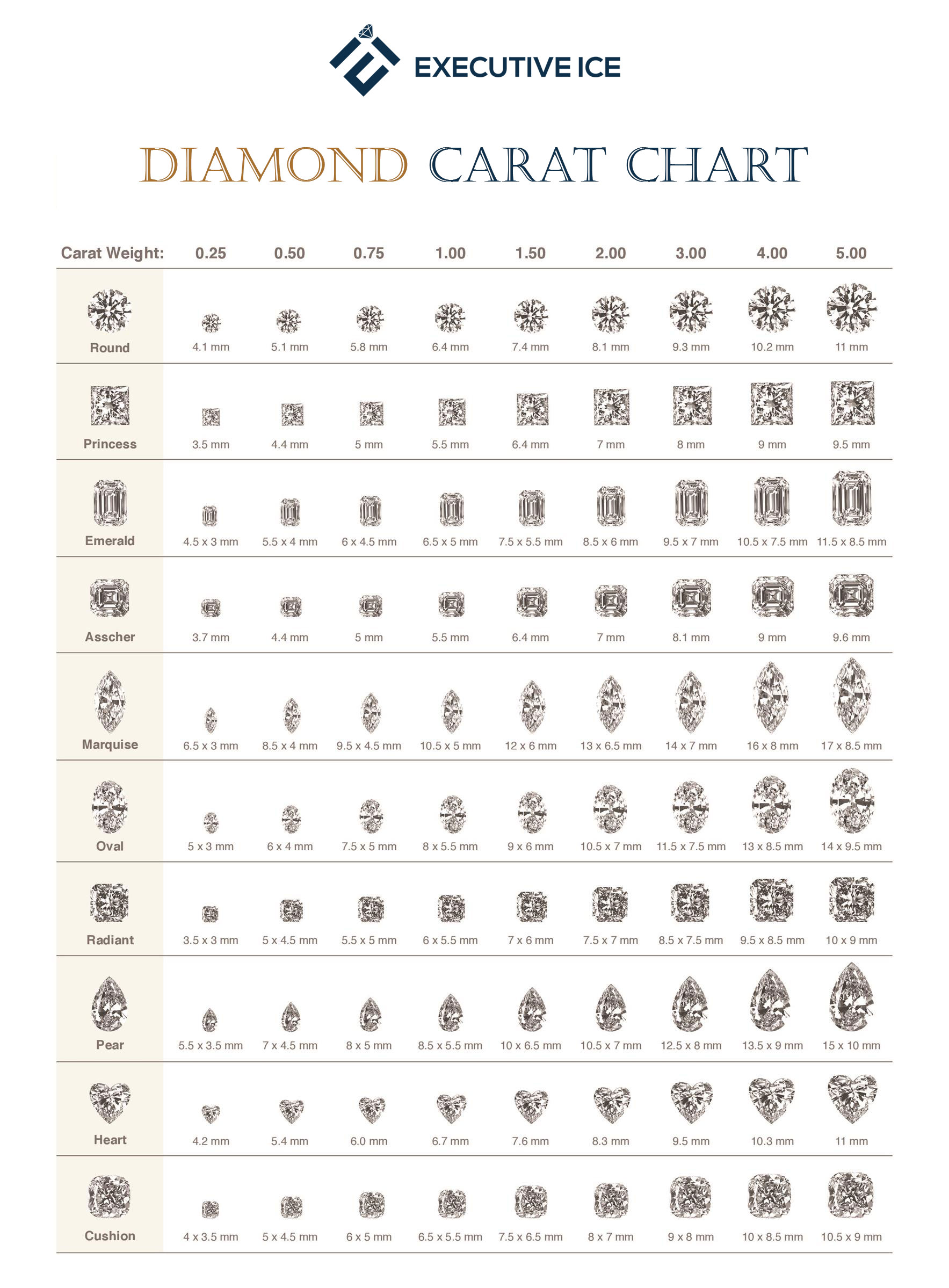
-
Diamonds Actual Size on Hand By Shape
Explore how different diamond shapes of actual size appear on the hand, offering a realistic perspective for choosing the right gem.

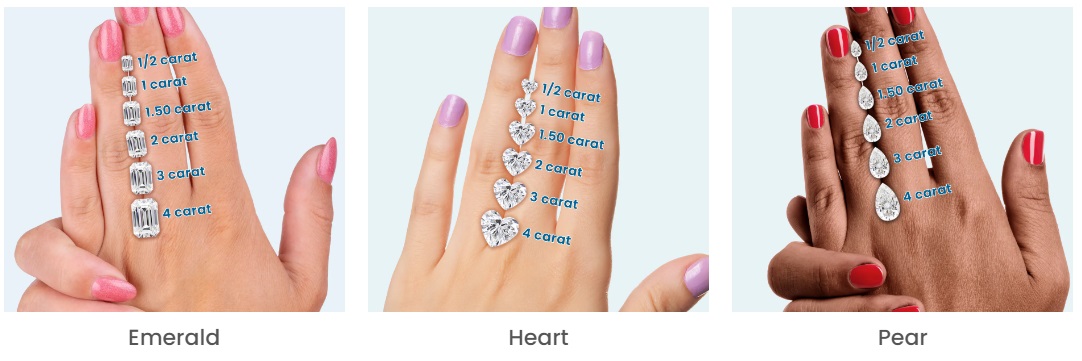
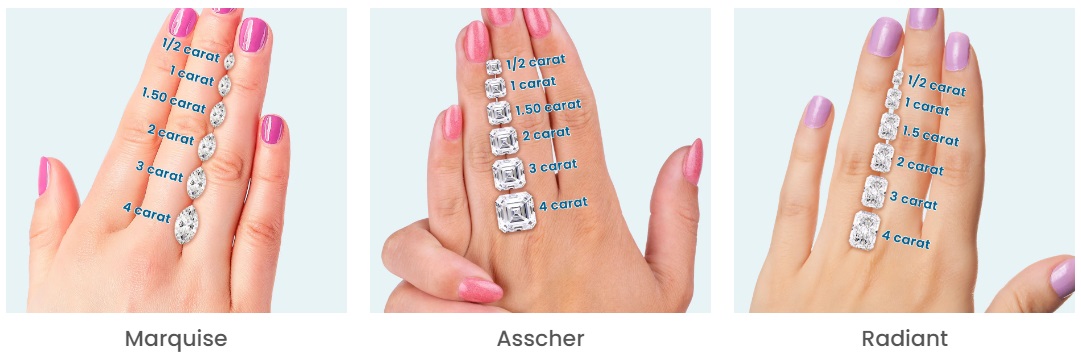
Images Source: brilliance
4. How Carat Affects Price
-
Relationship between carat weight and diamond price
In the diamond world, the carat weight of a diamond plays a big part in determining how much it’s going to cost you.
Think of carat weight like the size of a catch when you’re fishing. The bigger the fish, the more it’s worth. Similarly, the more a diamond weighs, the more you can expect to pay for it. But here’s the interesting part – this relationship isn’t exactly straightforward.
Diamond prices don’t just go up in a steady line as the carat weight increases. They jump up at certain popular weights, like at half a carat, one carat, and so on. It’s like stepping up a staircase where some steps are taller than others. Why? Because there’s a high demand for certain sizes, and hitting these ‘magic numbers’ makes a diamond more desirable.
Also, larger diamonds are rarer than smaller ones. Finding a big diamond is like finding a large, perfectly shaped leaf in a forest; they’re not as common. This rarity makes larger diamonds more valuable, and so, the price per carat increases as the size of the diamond goes up.
But keep in mind, carat is just one part of the story. The overall value of a diamond also depends on its cut, color, and clarity. A larger diamond with poor cut, color, or clarity might not be as valuable as a smaller diamond with better overall qualities.
In the end, understanding the relationship between carat weight and price can help you make a smart choice. It’s about finding the right balance – getting the size you want without overshooting your budget, and making sure you’re also getting a diamond that looks good in all the other ways that matter.
-
Price increments at popular carat weights
Let’s delve into something pretty interesting about diamond prices – how they jump at certain popular carat weights. It’s like walking up a hill where some slopes are steeper than others.
In the world of diamonds, certain weights are what we call ‘magic numbers’ – like half a carat, one carat, one and a half carats, and so on. These sizes are highly sought after, kind of like the big, shiny apples at the top of the tree everyone wants to pick.
When a diamond’s weight gets close to these magic numbers, its price per carat can jump significantly. For instance, a 0.95-carat diamond will be priced lower per carat than a 1-carat diamond, even though they’re almost the same size. It’s like the price takes a little leap right when it hits that one-carat mark.
The same pattern appears at other popular weights. As you approach these key carat weights, the price per carat tends to jump up. It’s because of the demand for these sizes – they’re milestones, like a kid’s height chart where certain heights are extra special.
But remember, while these price jumps at popular weights are common, the overall value of a diamond isn’t determined by carat weight alone. As mentioned factors like cut, color, and clarity also play major roles. A smaller diamond with excellent qualities in these other areas might be worth more than a larger diamond that just hits a magic weight but falls short in other aspects.
So, when you’re out there diamond hunting, keep these popular carat weights and their price behaviors in mind. It’s all about striking that sweet balance – getting a diamond that not only meets your desired size but also gives you the best overall value for your money.
5. Choosing the Right Carat Weight
-
Factors to consider when selecting carat weight
Choosing the right carat weight for your diamond is like picking the right size canoe for a river trip – it’s got to be just right for your journey. Here are some things to ponder when you’re deciding on the carat weight:
-
Budget:
First things first, think about your spending plan. Larger carat diamonds cost more, so consider what fits comfortably within your budget. It’s like planning a trip; you’ve got to know how much you can spend on the journey.
-
Personal Preferences:
What’s your style? Do you like big and bold, or subtle and understated? Your personal taste plays a big part in choosing the carat weight. It’s like choosing a hat – some like them wide-brimmed, others prefer a subtle cap.
-
Size of the Finger:
The size and shape of the finger wearing the diamond can influence how big or small the diamond appears. A larger carat diamond might look just right on a larger hand, while on a smaller hand, a smaller carat could be perfect. It’s all about proportion – like matching the size of a canoe to the river you’re navigating.
-
Setting and Design:
The setting of the diamond can make a big difference in how the carat weight looks. Some settings can make a smaller diamond appear larger, while others showcase the size as is. It’s like framing a picture – the right frame can make the image stand out just right. See, for example, this setting that influences the apparent size, known as the prong setting, like this one on James Allen:
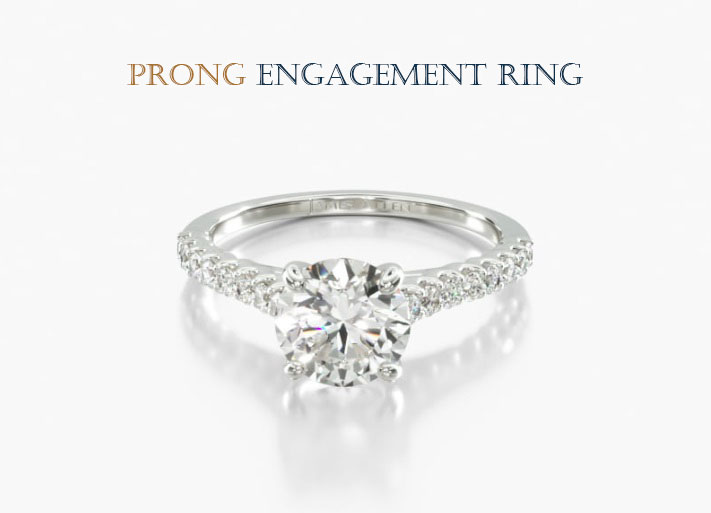
Image Source: James Allen
-
Overall Look:
Consider how the carat weight works with the diamond’s other qualities – its cut, color, and clarity. Sometimes, a smaller carat diamond with excellent cut and clarity can be more appealing than a larger diamond with lower quality in other aspects. It’s like choosing a smaller, more scenic path that offers a better experience than a wider, plainer one.
In the end, selecting the right carat weight is about balancing these factors to find a diamond that not only appeals to your eyes and heart but also feels right in your life and story. It’s a personal choice, like picking the right path on a trail – it’s got to feel right for you.
-
Balancing carat weight with other diamond characteristics (cut, color, clarity)
When you’re picking a diamond, it’s like finding harmony in a song – you’ve got to balance the carat weight with other features like cut, color, and clarity.
-
Carat and Cut:
The cut of a diamond can affect how big it looks, regardless of its carat weight. A well-cut diamond can appear larger and more brilliant, even if it’s not the heaviest. It’s like a well-tuned instrument – it might not be the biggest, but it sure can make beautiful music.
-
Carat and Color:
Carat weight and color also play a dance together. Sometimes, in larger diamonds, color can be more noticeable. So, if you’re going for a bigger carat, make sure the color grade is something you’re happy with. It’s like choosing a larger canvas for a painting; you want to ensure the colors are just right.
-
Carat and Clarity:
Then there’s clarity to consider. Larger diamonds might show imperfections more clearly, so balancing carat size with clarity is key. It’s like looking through a bigger window – any smudges are easier to see.
-
Overall Balance:
The trick is to find the right mix of these qualities that works for you and your budget. Maybe a slightly smaller diamond with excellent cut and clarity is more appealing than a larger one with visible imperfections. It’s all about what catches your eye and feels right in your heart.
Remember, each diamond is unique, with its own set of characteristics. Balancing carat weight with cut, color, and clarity is about creating a harmony that sings to you. It’s not just about the size of the stone, but the whole picture it paints when all these features come together.
6. Carat Weight and Diamond Shapes
-
How different shapes affect the appearance of carat weight
How the shape of a diamond can make a big difference in how its carat weight appears. It’s like looking at different types of containers – they can hold the same amount, but their shape can make them look bigger or smaller.
-
Round Cuts:
Image Source: James Allen
Start with the classic round cut. These diamonds often appear smaller per carat compared to other shapes. It’s because a lot of their weight is in the depth, which helps with their sparkle but doesn’t add to their size. It’s like a deep cooking pot – it holds a lot, but doesn’t look as big on the outside.
-
Oval and Marquise Cuts:
Image Source: James Allen
Now, oval and marquise cuts tend to look larger for their carat weight. Their elongated shapes spread the weight over a larger area, so they have a bigger surface to show off. It’s like a shallow, wide pan – it looks bigger at first glance.
-
Emerald and Asscher Cuts:
Image Source: James Allen
These shapes, with their step cuts, can vary. Sometimes they look larger because of their wide table (the top flat part of the diamond), and other times, they can appear smaller due to their deep cut. It’s like comparing a box to a bag – depending on how you shape it, it can look different.
-
Princess Cuts:
Image Source: James Allen
Princess cuts are interesting. They usually look slightly smaller per carat weight compared to elongated shapes, but they can still pack a lot of brilliance and fire. It’s like a compact book with a lot of interesting stories inside.
The key takeaway here is that carat weight isn’t the only thing to consider when judging a diamond’s size. The shape plays a big role in how large or small a diamond appears. So when you’re choosing your diamond, think about how different shapes might enhance or reduce the visual impact of the carat weight.
It’s like picking the right vessel for the right journey – each shape offers a different experience and appearance, even if they carry the same amount.
7. Tips for Maximizing Carat Weight Within Budget
-
Strategies for finding larger looking diamonds at lower carat weights
Let’s talk about how you can get a diamond that looks big and beautiful without weighing heavy on your wallet. It’s like finding the best view on a hike without having to climb the tallest mountain.
-
Choose Slimmer Shapes:
Go for shapes like oval, marquise, or pear. These elongated shapes spread the carat weight over a larger area, so they tend to look larger than round or square cuts of the same weight. It’s like laying out a blanket – stretched out, it covers more ground.
-
Consider the Cut:
A well-cut diamond can appear larger than its actual carat weight. Look for cuts that maximize the stone’s surface area and have a shallower depth. Just make sure the cut still allows for good light reflection – you want it to sparkle!
Below is a visual comparison of three diamonds, identical in carat weight yet differing in size due to their unique cuts and proportions:
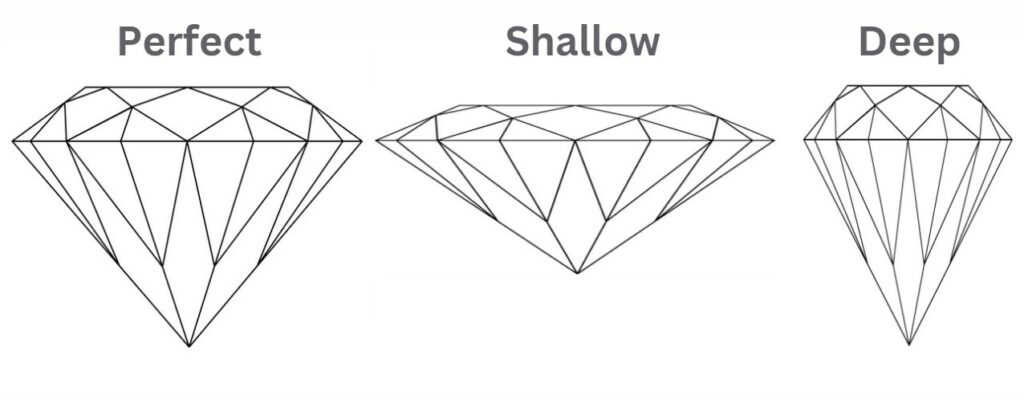
-
Opt for a Slim Setting:
The setting of the diamond can play tricks on the eye. A slim, delicate setting can make the diamond itself look bigger. It’s like wearing a plain outfit to make a colorful scarf stand out.
-
Go for a Halo Setting:

Image Source: Blue Nile
A halo setting, where smaller diamonds encircle the main stone, can make the center diamond look larger.
-
Be Smart with Clarity and Color:
You can choose a diamond with slight inclusions or a bit of color. Often, these aren’t visible to the naked eye, especially in smaller carat weights, but they can lower the price. It’s like finding a beautiful flower with a tiny imperfection – it’s still lovely, but less expensive.
-
Side Stones Can Add Impact:
Consider designs with side stones. They add to the overall impact of the ring without needing a larger center stone. It’s like decorating a room – the right accents can make the space feel richer without a big centerpiece.
With these strategies, you can find a diamond that makes a big impression without a big investment. It’s all about being a bit clever and creative with your choices.
-
How to prioritize carat weight in your diamond purchase
When you’re in the market for a diamond, deciding how to prioritize carat weight while sticking to your budget can be like finding the best path through a forest – you want the most scenic route without getting lost.
-
Determine Your Must-Haves:
First, figure out what’s most important to you in a diamond. Is size the main factor, or are you more concerned with clarity and color? Knowing your priorities helps in balancing carat weight with other qualities.
-
Understand the Trade-offs:
If carat weight is your top priority, you might need to be flexible with other features like color and clarity. It’s like if you want a bigger tent for camping, you might compromise a bit on the weight or brand.
-
Consider Slightly Below Standard Weights:
Look for diamonds just under popular carat weights, like 0.9 instead of 1 carat. They can cost significantly less and the size difference is barely noticeable. It’s like buying a 19-ounce bag of chips instead of a 20-ounce – you hardly see the difference.
-
Maximize the Cut:
A well-cut diamond can make the most of its carat weight, appearing larger and more brilliant. Opting for a superior cut can make a slightly smaller diamond look just as impressive.
-
Shape Matters:
Some diamond shapes appear larger than others at the same carat weight. For instance, marquise, oval, and pear shapes tend to look larger than round or square cuts.
-
Balanced Proportions:
Pay attention to the diamond’s proportions. A diamond that’s too deep may carry more of its carat weight hidden below, making it appear smaller. A well-proportioned diamond will showcase its size more effectively.
Buying a diamond is a personal experience, and prioritizing what matters most to you is key. By focusing on carat weight while considering these tips, you can find a diamond that not only meets your size preferences but also fits beautifully within your budget. It’s all about making smart choices to find that perfect gem.
8. Caring for Different Carat Sizes
-
Specific care considerations for diamonds of varying carat sizes
Alright, just like different plants in your garden need different care, diamonds of various carat sizes need their own kind of attention.
-
Larger Carat Diamonds:
For those big, show-stopping diamonds, remember they can be more prone to wear and tear because of their size. It’s important to regularly check their settings, especially if they’re in a high setting like a solitaire. Think of it like a tall tree in your yard – it needs a bit more attention to make sure it’s standing strong. also, It’s wise to remove larger carat diamond rings before doing any strenuous activities.
-
Smaller Carat Diamonds:
While these might not be as prone to damage due to their size, they can be more likely to get lost if not set securely. For smaller carat diamonds, especially those in pavé or similar settings, ensure they’re checked regularly to keep them snug in their spots. It’s like keeping an eye on the smaller plants in your garden to make sure they aren’t overshadowed or lost.
-
Regular Cleaning:
No matter the size, all diamonds love a bit of sparkle. Clean them regularly with a soft brush and mild soapy water. Larger diamonds might need a bit more cleaning to keep their brilliance, as they have larger surfaces that can collect oils and dirt.
-
Safe Storage:
Bigger diamonds should be stored separately to avoid scratches. For smaller diamonds, particularly those in pieces with multiple small stones, ensure they’re stored where they won’t rub against other jewelry and dislodge. It’s like giving each plant its own space to grow without bumping into its neighbors.
-
Professional Checkups:
Take your diamonds, regardless of size, for professional checkups. Jewelers can spot issues like loose settings or potential damage that you might miss. It’s like taking your car in for a tune-up – sometimes you need a professional’s eye.
Each diamond, big or small, is a treasure. Giving them the right care based on their size ensures they stay beautiful and brilliant, just like the day you first laid eyes on them. It’s all about understanding their needs and providing the right kind of care.
9. FAQs About Diamond Carat
-
Addressing common questions and misconceptions
Here we go, diving into some of the most common questions and misconceptions about diamond carat. Think of it as sitting around a campfire, sharing stories and setting the record straight.
-
What is carat for diamond?
A carat, when it comes to diamonds, is a unit of weight used to measure the size of a diamond. One carat is equivalent to 200 milligrams. The term ‘carat’ is the primary indicator of a diamond’s weight, not its size. The size or the dimensions of the diamond are influenced by how the diamond is cut, which is a secondary factor. So, while the carat weight tells you how much a diamond weighs, the cut and shape of the diamond determine its apparent size. Understanding both the carat weight and the cut of the diamond is essential when selecting the perfect gem.
-
Which carat of diamond is best?
The “best” carat of diamond largely depends on individual preferences and budget. There isn’t a one-size-fits-all answer, as the ideal carat weight varies based on personal taste, the style of the setting, and financial considerations.
For some, a higher carat diamond, which indicates a heavier stone, may be desirable for its presence and rarity. However, it’s important to balance carat weight with other diamond characteristics like cut, clarity, and color. A diamond with a high carat weight but poor cut or clarity might not be as visually appealing as a smaller diamond with excellent cut and clarity.
In essence, the best carat weight for a diamond is one that aligns with your personal preferences and fits within your budget, while also considering the overall quality and appearance of the stone. It’s about finding harmony between the carat weight and other attributes to choose a diamond that truly resonates with you.
-
What is 24 carat diamond?
A 24 carat diamond is a misnomer, as diamonds are not measured in purity like gold. The term “carat” in relation to diamonds refers solely to the weight of the diamond, not its purity. One carat equals 200 milligrams. When it comes to purity, gold is measured in carats, with 24 carats signifying pure gold.
In contrast, diamonds are evaluated based on the 4Cs: Carat (weight), Cut, Color, and Clarity. The carat weight of a diamond measures how much the diamond weighs, and has no bearing on the purity or quality of the diamond itself. It’s crucial to understand this distinction to avoid confusion when discussing diamonds and gold, as the term “carat” has different implications in each context.
-
What is 1 carat diamond worth?
The worth of a 1 carat diamond can vary significantly based on several factors, including its cut, color, clarity, and where it’s purchased. There’s no fixed price for a 1 carat diamond, as its value is influenced by these characteristics.
Cut:
The quality of the cut greatly impacts the diamond’s brilliance and overall appearance, which can affect its price.
Color:
The color grade, which ranges from colorless to light yellow or brown, also plays a role in determining the diamond’s value.
Clarity:
Clarity refers to the presence of internal inclusions or external blemishes, and higher clarity can increase the diamond’s price.
Certification and Store:
The source of the diamond, such as reputable stores like Blue Nile or James Allen, and its certification also contribute to its overall worth.
Given these variables, the price of a 1 carat diamond can range from a few thousand dollars to several thousand. For accurate pricing, it’s advisable to check current listings and consult with professional jewelers or trusted online retailers like Blue Nile and James Allen. These stores provide a wide selection of certified diamonds, allowing for a comparison of prices based on the specific qualities of each stone.
-
What is the most popular carat size?
The most popular carat size for diamonds, particularly in engagement rings, tends to be around 1 carat. This size is often sought after due to its ideal balance of noticeable size, aesthetic appeal, and affordability.
Visual Appeal:
A 1 carat diamond is large enough to have a significant presence and provide considerable sparkle, making it visually appealing for a variety of jewelry types, especially engagement rings.
Affordability:
While still representing a considerable investment, 1 carat diamonds are generally more affordable than larger carat sizes. This makes them accessible to a broader range of buyers, balancing cost with the desire for a sizable and beautiful diamond.
Versatility:
Diamonds around 1 carat are versatile in terms of fitting various settings and styles. They are large enough to stand alone as a solitaire but also work well with additional accent stones or in more elaborate settings.
Cultural and Market Trends:
The popularity of the 1 carat diamond is also influenced by cultural preferences and market trends. It has become a sought-after standard in many regions, often seen as the ideal size for an engagement ring.
While 1 carat diamonds are widely popular, it’s important to note that the best carat size for any individual depends on personal preference, budget, and the specific style of the jewelry. Some may prefer smaller or larger diamonds based on their personal taste, hand size, or lifestyle.
-
Is a higher carat diamond always better?
Not necessarily. A higher carat means a heavier diamond, but it doesn’t always mean it’s ‘better’. The overall beauty of a diamond depends on a balance of carat, cut, color, and clarity. It’s like a stew – it’s not just about the quantity of the ingredients, but how well they all come together.
-
Does a bigger carat mean a much bigger diamond?
Not always. The way a diamond is cut can affect how large it appears. Sometimes, a diamond with a bigger carat weight won’t look significantly larger than one with a slightly smaller weight. It’s like two trees of similar height; one might have a thicker trunk, but it doesn’t necessarily make it look much taller.
-
Are two half-carat diamonds equal to one carat?
In weight, yes, but not in value. A single one-carat diamond is generally more valuable than two half-carat diamonds because larger diamonds are rarer. It’s like finding a single, large ancient artifact compared to finding smaller, more common pieces.
-
Does carat weight determine how sparkly a diamond is?
The sparkle of a diamond, also known as its brilliance, is more about the cut than the carat weight. A well-cut diamond of any size can be incredibly sparkly. It’s like a small light in the dark – if it’s bright enough, it can light up the whole area.
-
Is it better to prioritize carat over other characteristics?
It depends on personal preference. Some might prefer a larger stone, while others might value clarity or color more. It’s about what’s most important to you. It’s like choosing a camping spot – do you prefer a larger site or one with a better view?
10. Conclusion
-
Summary of key points about diamond carat
Gathering our thoughts on diamond carat, let’s reflect on the key points we’ve explored in this guide. Carat, a measure of a diamond’s weight, plays a significant role in defining the stone’s size, value, and overall appeal.
Carat Weight and Size Perception: Remember, carat weight indicates the diamond’s weight, not its size. Different shapes and cuts affect how large the diamond appears, even with the same carat weight.
The Impact on Price: As the carat weight increases, so does the price, but not always in a linear fashion. Price jumps can occur at certain popular carat weights due to demand and rarity.
Choosing the Right Carat: Picking the right carat weight involves balancing personal preferences, budget, and other diamond characteristics. It’s not just about the weight, but how it complements the diamond’s cut, color, and clarity.
Popular Carat Weights: While 1 carat diamonds are popular due to their balance of size, visibility, and affordability, the ‘ideal’ carat size varies based on individual tastes and needs.
-
Final thoughts and advice for buyers considering carat weight
Wrapping up our discussion on diamond carat weight, here are some final thoughts and pieces of advice for buyers navigating this aspect of their diamond purchase.
When considering carat weight, think of it as one piece of a larger puzzle. It’s important, but it’s not the only factor that determines the beauty and value of a diamond. Here’s what to keep in mind:
Balance with Other Features: Don’t focus solely on carat weight. A balanced consideration of the diamond’s cut, color, and clarity, alongside the carat, will lead to a more satisfying purchase.
Consider Personal Style and Budget: Your choice should reflect your personal style and what you’re comfortable spending. Sometimes, a smaller diamond with exceptional qualities can be more appealing than a larger diamond of lesser quality.
Understand Size Perceptions: Remember that different shapes and cuts can make a diamond of the same carat weight appear larger or smaller. Consider the overall appearance of the diamond, not just its carat weight.
Practicality for Lifestyle: Consider your lifestyle or the lifestyle of the person who will wear the diamond. Larger carat weights can be impressive, but they might not be practical for everyday wear.
Seek Professional Advice: Don’t hesitate to consult with a trusted jeweler or diamond expert. Their guidance can be invaluable in understanding how carat weight affects the diamond’s overall look and value.
In conclusion, selecting the right carat weight is a personal journey. It’s about finding that sweet spot where the diamond’s size meets your desires, needs, and expectations, creating a piece that you’ll treasure for years to come. Remember, it’s not just about the size; it’s about the story and the meaning behind your diamond.


